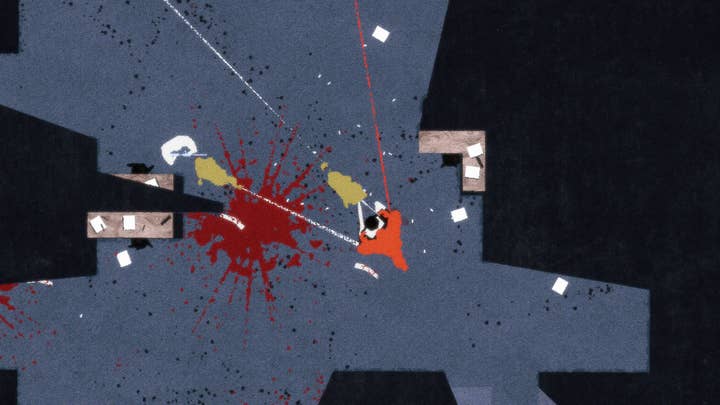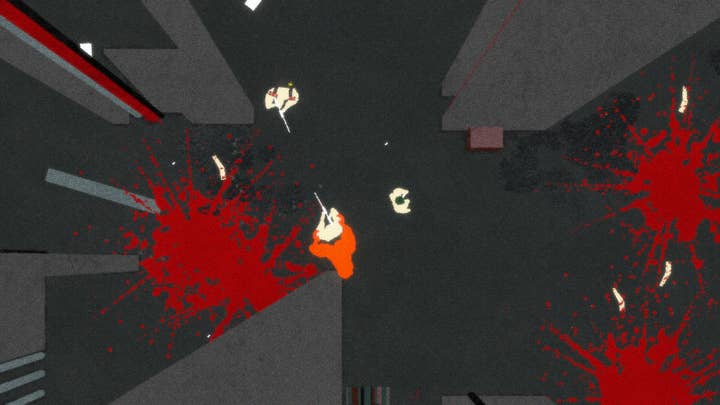Ape Out: Understandable in a split second | Why I Love
BugBomb CEO Łukasz Goraczewski says ape escape caper took him back to another time and Another World
Why I Love is a series of guest editorials on GamesIndustry.biz intended to showcase the ways in which game developers appreciate each other's work. This entry was contributed by Łukasz Goraczewski, Game Designer and CEO at BugBomb, which is releasing its party brawl game Gerrrms on Nintendo Switch on July 23.
Every once in a while, there comes a game that strikes a chord with the most deeply ingrained pieces of what makes you a gamer. For me, the most recent game to achieve that was Ape Out, released by Devolver in 2019. It managed to remind me what made me a gamer and ultimately shaped me as a game designer.
I grew up in the north of Poland in the '90s. This was a time of turmoil and wonder. With the communist regime overthrown and the sudden openness of borders, we found ourselves gasping at the sheer amount of goodness pouring in from the West. In the eyes of a six-year-old, this meant primarily an influx of entertainment.
The very first machine I had the pleasure to use was a Commodore 64 with a complementary floppy disc drive, taking huge 5.25" discs. The hardware was there, but in the pre-internet times it was very difficult to get a hold of any software.
"I was enthralled when I first saw Ape Out. I immediately recognized the same flair that seemed to fuel the games of my childhood"
It might come as a shock to someone born in the '90s or growing up in Western Europe, but intellectual property wasn't protected at all back then. Everywhere you looked, there appeared shops that offered the copying service for the hapless Commodore 64 or Amiga user. Those were small kiosks with a photocopied, greasy lists of available games that you could choose from. They featured brutally short descriptions, for example "nice racing" was the description for Lotus Turbo Challenge and "strategy, save little guys" for Lemmings. The prices depended on the number of floppies the games occupied, so those that took more were less likely to get copied. Once you made your choice, the guy running the shop copied the game while you waited. That was it.
But the absolute peak of piracy was reached when one of the radio stations started broadcasting games - over radio waves. Those who were lucky to own a cassette deck (as a form of storage alternative to floppies) could simply record the transmission and then just pop it into their Commodores.
Due to obvious hardware limitations of that era, the games were based on tricks in order to convey the message that the author wanted, both graphically and story-wise. The great example here is Another World, which to this day is to me an example of a gem that stands the test of time. Simple, but powerful graphics, with instantly recognizable color palette. Eric Chahi set the standard for impactful presentation, that I cannot help but admire to this day. I think I'm not the only one to stay deeply influenced by that masterpiece. That truly was a game to evoke powerful feelings with simple means.
It's also worth noting that games back then were unforgivingly difficult. Save options weren't widely employed, clues for the player were scarce, and gameplay involved a lot more skill, grinding, and figuring things out. It is interesting to see games that are labelled as hard nowadays, but would be considered quite ordinary in the early '90s.
It shouldn't come as a surprise now that I was enthralled when I first saw Ape Out. I immediately recognized the same flair that seemed to fuel the games of my childhood. It looks and plays like an outcome of a crystal-clear vision, the sort of eureka moment that you just wake up with one day and then spend the upcoming months and years to take this vision to fruition. In the world of multi-layered, sprawling games that mimic other games, it is increasingly difficult to find a piece so cohesive, thought through and clear.
I admire Gabe Cuzzillo's laser-sharp focus on the aim here. He wanted to encapsulate the feeling of a wild escape, the raw, untamed strength and fury of an ape running from a lab. You can deeply feel that animalistic drive, anger, and terror as you try to make your way through a labyrinth. The means of expression that were employed fit the task at hand perfectly.

Firstly, there's the story: understandable in a split second. You're an ape, there are people with guns, you need to escape. A single GIF is all you need to convey this. As a game designer, I understand how difficult it is to design a game that could be understood in a split second. It's become one of the success factors in today's world, where the fight for user's attention decides whether you succeed or slip into oblivion.
"Ape Out's graphics remind me of Another World; they prove you don't need a plethora of colors and details to make a memorable impression"
I admire the simplicity of the labyrinths. They aren't overwhelming, but still manage to create pressure to keep you moving. It is another great tool for portraying an ape's perspective. An animal wouldn't understand the intricacies of architecture, all walls are similar, they are barriers on your way to freedom. That's why you don't need to differentiate between them: they're ultimately just obstacles.
The graphics in the game are also something that requires courage and taste these days. With numerous indies trying to make a statement with variations of composition, camera angles and twists on pixel art, it takes a bold poster style to really stand out. Ape Out's graphics remind me of Another World; they prove you don't need a plethora of colors and details to make a memorable impression. Simple shapes, a handful of colors and a texture filter for noise is all you need. Surely, it doesn't have the mass appeal of "nicer" games, but it embodies the artist's vision and as such it is commendable. It took courage to limit oneself to this style, but it was definitely worth it. Ape Out became one of the most memorable games in recent years.
And then, there is the music. Many words were written about it already, but I feel it needs to be praised whenever possible. The use of jazz was a true lick of genius here. You can't shake the feeling that the entire game is like a jazz album. The visuals bring a record's cover to mind, the levels are composed like bursts of free jazz. It's like you're listening to Ken Vandermark's recordings; they are explosions of primal, untamed energy, as animalistic as the survival instinct of the game's eponymous ape. It is a brilliantly tasteful concoction. The music fits the game like a glass of fine wine fits an elegant dinner.
I am aware that this might be a demanding title for some players, not only due to the relatively high difficulty level, but also due to the harshness of artistic expression. The constant pressure on the escape and running is tiring. Some players might find it overwhelming, before they feel the relief of the game's finale (a break through into a forest). I'm sure Gabe Cuzzillo was perfectly aware of that, but pursued his vision nonetheless, which is exactly what indie pride should be about. After all, free jazz is also an acquired taste.
Developers interested in contributing their own Why I Love column are encouraged to reach out to us at news@gamesindustry.biz.
